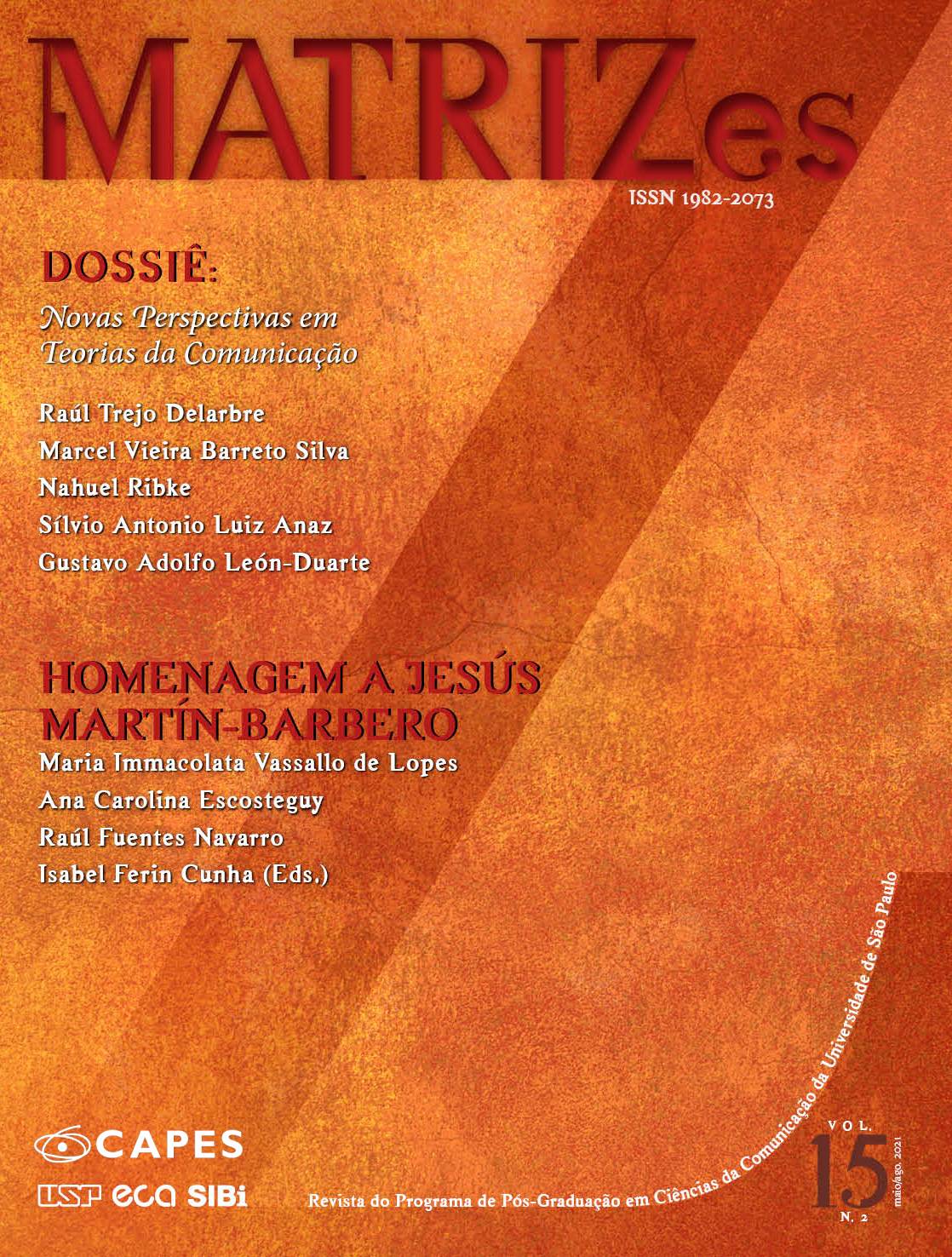Middle Range Theory in Communication. Constitutive elements for a model of communication as culture
DOI:
https://doi.org/10.11606/issn.1982-8160.v15i2p95-118Keywords:
Communication;, Theory;, Applied research;, Models;, Teaching;Abstract
This article examines and discusses the meta-theoretical assumptions that must be taken into account when teaching a Medium Range Theory (MRT) in Communication. First, they examine the broader theoretical approaches and models to highlight the functionality of ontological and epistemological meta-theoretical assumptions. In a second moment, critically discusses the historical implications of the construction of a MRT in Communication to focus on the descriptive integration of a Constitutive Model of Communication as Culture (CMCC). From the analysis of primary and secondary sources specialized in the subject, the method of constant comparison of the grounded theory was applied to elaborate the argumentative relationships that constitute the CMCC integrated conceptual theoretical framework. The CMCC can be conceived as a MRT in communication since its conceptual theoretical proposal and its interpretative and heuristic approach offer a powerful support to address simple and complex problems in the real practice of the communication specialist
Downloads
References
Argyris, C. (1995). Knowledge when used in practice tests theory: The case of applied communication research. In K. Cissna (Ed.), Applied communication in the 21st century (pp. 1-19). Routledge.
Belgrave, L., & Seide, K. (2019). Grounded theory methodology: Principles and practices. In P. Liamputtong (Ed.), Handbook of research methods in health social sciences (pp. 299-316). Springer. https://doi.org/10.1007/978-981-10-5251-4_84
Calhoun, C. (2017). Integrating the social sciences. In R. Frodeman, J. Klein, & R. Pacheco (Eds.), The Oxford handbook of interdisciplinarity (pp. 117-130). Oxford University Press.
Carey, J. (2009). Communication as culture: Essays on media and society. Routledge.
Corbin, J., & Strauss, A. (2014). Basics of qualitative research: Techniques and procedures for developing grounded theory. Sage.
Craig, R. (1999). Communication theory as a field. Communication theory, 9(2), 119-161. https://doi.org/10.1111/j.1468-2885.1999.tb00355.x
Craig, R. (2007). Pragmatism in the field of communication theory. Communication Theory, 17(2), 125-145. https://doi.org/10.1111/j.1468-2885.2007.00292.x
Craig, R. (2013). Theories and models of communication. De Gruyter Mouton. https://doi.org/10.1515/9783110240450
Craig, R. (2015). The constitutive metamodel: A 16-year review. Communication Theory, 25(4), 356-374. https://doi.org/10.1111/comt.12076
Craig, R. (2016). Pragmatist realism in communication theory. Empedocles: European Journal for the Philosophy of Communication, 7(2), 115-128. https://doi.org/10.1386/ejpc.7.2.115_1
Craig, R. (2018). For a practical discipline. Journal of Communication, 68(2), 289-297. https://doi.org/10.1093/joc/jqx013
Craig, R. (2019). Welcome to the metamodel: A reply to Pablé. Empedocles: European Journal for the Philosophy of Communication, 10(1), 101-108. https://doi.org/10.1386/ejpc.10.1.101_1
Craig, R., & Tracy, K. (1995). Grounded practical theory: The case of intellectual discussion. Communication Theory, 5(3), 248-272. https://doi.org/10.1111/j.1468-2885.1995.tb00108.x
Cushman, D., & Craig, R. (1976). Communication systems: Interpersonal implications. In G. R. Miller (Ed.), Explorations in interpersonal communication (pp. 37-58). Sage.
Dewey, J. (1916). Democracy and education. Macmillan.
Dewey, J. (1934). Art as experience. Balch.
Durham, M., & Kellner, D. (Eds.). (2012). Media and cultural studies: Keyworks (2a ed.). John Wiley & Sons.
Hine, C. (2007). Multi-sited ethnography as a middle range methodology for contemporary STS. Science, Technology, & Human Values, 32(6), 652-671. https://doi.org/10.1177/0162243907303598
Jørgensen, U. (2001). Grounded theory: Methodology and theory construction. In N. Smelser & P. Baltes (Eds.), International encyclopedia of the social & behavioral sciences (pp. 6396-6399). Elsevier.
León-Duarte, G. (2002). Teorías e investigación de la comunicación en América Latina. Situación actual. Ámbitos: Revista Internacional de Comunicación, (7-8), 19-47. https://bit.ly/3gW26zw
León-Duarte, G. (2010). Sobre la institucionalización de la comunicación en América Latina. Pearson.
León-Duarte, G. (2015a, 5-7 de outubro de 2015). Transformaciones en el campo de estudios de la Comunicación en América Latina. Perspectivas epistemológicas y éticas en torno a la generación, la apropiación y la divulgación del conocimiento [Conferência magistral]. XV Encuentro Latinoamericano de Facultades de Comunicación Social, FELAFACS 2015. Medellín, Colombia.
León-Duarte, G. (2015b). La práctica interdisciplinaria aplicada al estudio de la comunicación y la información mediada por tecnología digital. RICSH: Revista Iberoamericana de las Ciencias Sociales y Humanísticas, 4(8), 363-381. https://bit.ly/2SuT832
León-Duarte, G. (2019). Aportes teóricos a la investigación del campo periodístico. Sentidos y significados desde el Campo Intelectual Creador. Intercom: Revista Brasileira de Ciências da Comunicação, 42(3), 41-59. https://doi.org/10.1590/1809-5844201932
Marcus, G. (1998). Ethnography through thick and thin. Princeton University Press.
Merton, R. (1968). Social theory and social structure. Free Press.
Sapienza, Z. S., Iyer, N., & Veenstra, A. S. (2015). Reading Lasswell’s model of communication backward: Three scholarly misconceptions. Mass Communication and Society, 18(5), 599-622. https://doi.org/10.1080/15205436.2015.1063666
Downloads
Published
Issue
Section
License

This work is licensed under a Creative Commons Attribution-NonCommercial-ShareAlike 4.0 International License.
Authors who publish in this journal agree to the following terms:
- Authors retain the copyright and grant the journal the right to first publication, with the work simultaneously licensed under the Creative Commons Attribution License (CC BY-NC-SA 4.0) which allows sharing of the work with acknowledgment of authorship and initial publication in this journal for non-commercial purposes.
- Authors are authorized to assume additional contracts separately, for non-exclusive distribution of the version of the work published in this journal (eg, publishing in institutional repository or as a book chapter), with acknowledgment of authorship and initial publication in this journal.






















